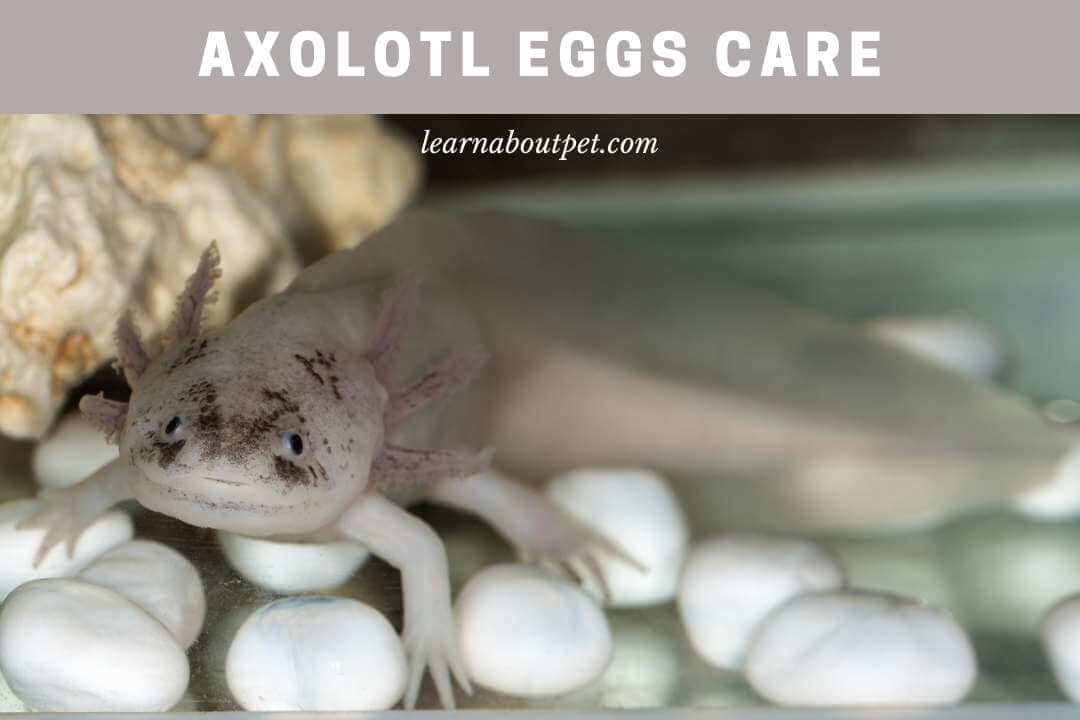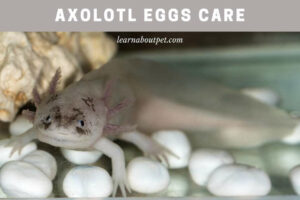You already have an axolotl and are trying to take care of the eggs, so you have lots of new axolotls? Of course, you should know how Axolotl eggs care works.
After the female axolotl lays their eggs (usually in plants), immediately separate them from the adult axolotl, so they don’t eat them. Make sure the tank with axolotl eggs is not exposed to sunlight and is at a cool temperature. Spread out the axolotl eggs in the tank until it hatches. Keep the water temperature at 18°C – 20°C.
If you want to do a regular water change, make sure the water temperature is constant and not more than the suitable temperature. To find out more, let’s read to the end about Axolotl eggs care.

How To Care For Axolotl Eggs?
The first thing that one has to take care of while collecting these tiny eggs is to keep the area’s temperature where they are collected cool. This ensures that the eggs are not affected by excessive heat.
When doing Axolotl eggs care, you can put them in a plastic tank without the reach of axolotl adults. When you move the eggs, there are no hand contacts. If the plant leaves are already attached to the axolotl eggs, gently transfer them to a new tank.
What do axolotl eggs look like? The axolotl eggs are cloudy and milky. Healthy axolotl eggs are white or black with a distinct jelly layer.
Axolotl Eggs, the first time you see them it is a bit confusing. They look like Jello blobs. But don’t be put off by that they are actually quite interesting and fun to watch.
It is very easy to get Axolotl eggs and they are a great addition to a home as a pet.
The Axolotls will lay the eggs on rocks, plants or other debris. They look for a dark area to lay the eggs in, they are able to be out in full light but most of the time prefer to hide them.
You can get Axolotl eggs from your local pet store, a breeder or someone that is caring for them and has extras laying around their tank(s). These can cost anywhere from $10-20 dollars or more depending on where you get them from and how many you buy.
They will come in a container with aquarium moss, this is for the eggs to grow into once they are placed into water.
You should set up tanks for your Axolotl eggs so that they can have the same environment as their parents did (that way it is less stress on the eggs when they are old enough to hatch).
How Are Axolotl Eggs Made?
So how are the eggs made? After being in love with axolotls for about 8 years now I still find things out about them all the time. For example, a recent conversation on an Axolotl forum got me very interested in egg care and laying behavior.
It turns out that most axolotls have 2 ovaries, but not all of them do. Some have 1 or 3 ovaries. I guess it all depends on the genetics of the animal and how their parents passed that trait down to their offspring.
The Axolotls lay eggs depending on the temperature and chemicals around them in combination with light cycles. The cooler temperatures can slow things down, but heat increases egg laying. It can occur all year round with some seasonal patterns.
How Many Eggs Do Axolotls Lay?
The number of eggs laid can vary from 1000 to over 1500. Axolotls generally lay eggs in clutches of 25 to 100, although this number varies. Male Axolotls will brood the eggs but cannot hatch them.
Interestingly, some Axolotl eggs contain two yolks and only one embryo develops with the help of a yolk sack (the other remains dormant).
What Do I Do With Axolotl Eggs?
If you want to treat axolotl eggs for sale, make sure you have a plastic tank with good water quality. This is very important for survival and axolotl growth while still eggs until hatching is complete.
All you have to do is transfer the female axolotl to a different tank to do egg-laying. Ensure the tank has lots of plants because female axolotls are more likely to lay eggs on plant leaves. One female axolotl can lay up to 1000 eggs. And the axolotl breeds at least twice a year.
You can tell the difference between fertilized and unfertilized axolotl eggs by their size. The size of fertilized eggs is between 1.1 and up to 1.5 cm, while unfertilized eggs are only up to 0.2 cm without spermatophores.
How Do I Know If My Axolotl Egg Is Fertilized?
If you are new to axolotl breeding, how to tell if axolotl eggs are fertilized? The fertilized axolotl eggs can be ascertained from their size, with a bigger diameter than the unfertilized one and reaching 1.1cm for the smallest size.
The fertilized one will appear to have a jelly cover to protect the contents of the egg. Fertilized axolotl eggs will look shiny and larger than unfertilized. After that, the hatching process will start between 14-30 days, depending on the water temperature stability in the tank.
Axolotl eggs care must pay attention to the tank’s temperature being stable—the warmer the water, the faster the axolotl eggs hatch. But make sure the temperature remains at a suitable temperature in 18°C – 20°C.
How Often Do Axolotls Lay Eggs?
If you have seen the spermatophore in the tank, you can move the female axolotl to another tank with plants for laying eggs. The next morning, you can see axolotl eggs begin to spawn.
It takes a female axolotl to lay eggs between 12 and 72 hours after mating. Some wait up to four days before they lay their eggs, although that is a rare case.
Axolotl eggs cloudy and milky if you can see them sticking to plant leaves or dropping to the bottom of the tank. Because the number of eggs reaches 1000, it tends to be in multiple clumps rather than a single mass.
After the female axolotl is done laying eggs, you can immediately do the Axolotl eggs care by adjusting the lighting and temperature of the tank to make it suitable for them to hatch.
When Should I Remove My Axolotl Eggs?
You will need to remove the axolotl eggs if you notice they are smaller and darker because they are unfertilized eggs. If you see fertilized eggs in plant leaves and in big glutes, you don’t need to remove them.
But if you see fungus on the plant where the axolotl eggs are, you need to remove the stuck eggs, so they are not on the plant.
You can move with your hands. But remember to wash your hands with soap first and make sure your hands are clean before handling axolotl eggs. Handle gently to prevent infection or damage the fertilized eggs.
How many axolotl eggs survive? It is very difficult to determine how many eggs can survive and reach the hatch because, in the wild, the mortality rate is also quite high. The key is a suitable temperature, and a separate place from the female axolotl after laying eggs is complete. If you don’t provide good quality conditions, the eggs die.
This is Axolotl eggs care because it ensures that they can be at the right temperature and in plants or places that stimulate their maximum growth.
Do Axolotls Eat Their Babies?
Your axolotl can eat eggs or their babies because they are notorious eaters. Therefore you have to separate the eggs and adults into one tank until they hatch.
Axolotl egg care is needed to prevent this from happening. Because we still don’t know from the eggs that have been released how many still survive until they hatch.
Can You Move Axolotl Eggs?
You can move the eggs with your bare hands, provided that your hands must be clean and washed with soap first. The eggs are strong, so you can move them directly by lifting the big clumps to another tank. It will be even easier if you remove the plants that the female axolotl uses for laying their eggs.

How many babies do axolotls have? It can reach 1000 per female axolotl, but to ensure that many survive, you have to do Axolotl eggs care.
Can Axolotls Change Gender?
Axolotl can’t change their genders, although other amphibians can do this. You must separate the genders when you breed them while waiting for them to be sexually active so that the eggs produced will have a higher chance of survival.
Baby axolotl eggs will be stronger if the female axolotl is more mature for sexual intercourse than the young one.
Even though Axolotl eggs care can be done, we still cannot be sure which ones will survive until hatching because fertilized and unfertilized eggs cannot be conditioned.
How Many Axolotl Eggs Will Survive?
The axolotl eggs manage to survive on clean water, good substrates, sufficient space, suitable temperature, and right pH levels.
It depends on whether you put the eggs in the sun or not, and also separate them from the female axolotl shortly after laying the eggs. This is necessary because axolotls can eat their eggs or their babies.
You need to learn from breeders who focus on baby axolotl eggs for sale because they take good Axolotl eggs care and increase the chances of them surviving.
How Do You Kill Axolotl Eggs?
If you find it too much to move axolotl eggs or Axolotl eggs care, you can freeze some eggs if they are less than three to four days old.
At that time, eggs still couldn’t feel anything because they weren’t developed yet. If it’s more than that, they start to take shape and can feel cold and pain if they are frozen.
Hatching axolotl eggs is fun if you want to take care of the many little axolotls you care for. But it will be overwhelming if you are new to axolotl care and have to look after more than 100 babies that will spawn shortly. Make sure you have enough capacity to accommodate them.
Can Axolotl Jump Out Of Tank?
If big enough, the axolotl can jump out of the tank, so you must have a hood or aquarium lid to prevent that from happening. But when you do Axolotl eggs care or until hatching occurs, no axolotl jumps out of the tank because they are not big enough.
This can only happen if you have ever removed a large axolotl from its tank or you have left the tank with the top open.
How Long Does An Axolotl Take To Grow?
The axolotl will grow to its maturity state for up to six months. After hatching until the juvenile, make sure you have enough space to care for them in large numbers and provide adequate food during the growth process.
When you do Axolotl eggs care, you still don’t need to be confused about supplying food, because until Axolotl eggs hatching, there is up to two days before they depend on outside food because they can still eat the egg yolk until they’re strong enough.
How Long For Axolotl Eggs To Hatch?
Many factors will determine this answer. Not all axolotl eggs hatch at the same speed and certain water temperature conditions.
Doing Axolotl eggs care can ensure it is hatched safely away from the mother so that the survival rate is higher. Besides that, it requires a tank with a large space of up to 14-30 days until they hatch perfectly.
Sometimes you have to separate the unfertilized axolotl eggs from the fertilized ones because the survivability is higher if they are already fertilized.
How To Tell If Axolotl Eggs Are Dead?
You can see malformation in axolotl eggs if there are air bubbles, which indicates they are dead. In addition, if you see a milky substance from axolotl eggs that is different from the usual cloudy or milky color, that is also a sign that the eggs are dead.
I looked for info about this at Axolotl eggs for sale near me because they do Axolotl eggs care by separating the living and dead eggs.
Axolotl Eggs Stages
You must understand the egg stages to know which eggs can survive to hatch and which do not develop. The table below will show the different stages from day to day until they hatch.
| Day | Stage |
| Day 1- Day 4 | The condition of eggs with white or black color with jelly that protects the outside of the eggs. |
| Day 5 – Day 8 | White or black color begins to spread on the inside of the jelly, with various shapes and signs that they have developed. |
| Day 8 – Day 11 | Already starting to see larvae with a slightly black color. |
| Day 11 or more | The larvae will continue to develop until they are small fish until they hatch without the legs. |
How To Hatch Axolotl Eggs?
The best way to hatch axolotl eggs is to allow them to do so naturally. The mother will care for the young and you don’t have to do anything other than make sure she has enough food. Their yolk sack supplies nutrients for about 7 days.
After that, the baby will feed on live foods like infusoria, daphnia, and blood worms. Some people have tried to hatch axolotl eggs in an incubator but their success rate is very low (due to high mortality rate). You can also use aquarium moss and keep the eggs moist until they hatch.
Hatched Axolotls
A baby axolotl is called a “neonate”. They are generally 1/2 of an inch long and can fit on your fingernail. The babies will eat anything they can catch including brine shrimp, bloodworms, daphnia and pieces of egg yolk. Their diet should consist of small live foods such as these until they grow large enough to eat their regular axolotl food.
Some people have had success with keeping baby axolotls in a 10-gallon tank with air stones and the right temperature control. Just make sure you don’t overfeed them so that they are able to grow into a healthy adult.
Final Verdict On Axolotl Eggs Care
If you want to have more axolotls, you need to know how to breed well and take care of the eggs until they hatch properly. Removing female axolotls after mating is necessary, so they can lay their eggs in a safer place and requires a special tank for eggs to be placed in rock or plant leaves.

After the laying process is complete, you can return the female axolotl to the previous tank so that the eggs can develop until they hatch. You can see the development of the eggs from the white color and the distinctive jelly to protect the eggs and a sign that the eggs have been fertilized.
Maintaining the water temperature and pH levels must be done because the survival rate will be higher with good Axolotl eggs care. If you can maintain good water quality until the hatchling process is complete, you will help your pet axolotls grow into healthy adults.

Welcome to Learn About Pet. My name is Rajkumar Ravichandran and I love all pets, travel, and amazing food. I write about my passion and personal experience caring for multiple pets in this blog! ❤️
Post Disclaimer
DISCLAIMER: THIS BLOG OR WEBSITE, "Learn About Pet", DOES NOT PROVIDE YOU WITH MEDICAL ADVICE AND IS NOT A SUBSTITUTE FOR MEDICAL ADVICE. ALWAYS GET IN TOUCH WITH YOUR PERSONAL VETERINARIAN AND USE INFORMATION HERE AS GENERAL ADVICE.
The information, including but not limited to, text, graphics, images and other material contained on this website are for informational purposes only. No material on this site is intended to be a substitute for professional veterinary advice, food recommendation, diagnosis, or treatment. Always seek the advice of your veterinarian or other qualified health care provider with any questions you may have regarding a medical condition or for pet food related questions.







